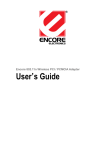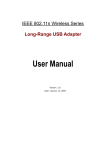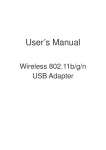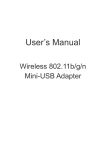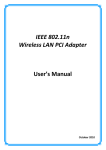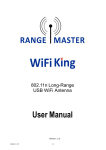Download ENCORE ENUWI-N
Transcript
Encore 802.11n Wireless USB Adapter User’s Guide FCC Certifications Federal Communication Commission Interference Statement This equipment has been tested and found to comply with the limits for a Class B digital device, pursuant to Part 15 of the FCC Rules. These limits are designed to provide reasonable protection against harmful interference in a residential installation. This equipment generates, uses and can radiate radio frequency energy and, if not installed and used in accordance with the instructions, may cause harmful interference to radio communications. However, there is no guarantee that interference will not occur in a particular installation. If this equipment does cause harmful interference to radio or television reception, which can be determined by turning the equipment off and on, the user is encouraged to try to correct the interference by one of the following measures: -Reorient or relocate the receiving antenna. -Increase the separation between the equipment and receiver. -Connect the equipment into an outlet on a circuit different from that to which the receiver is connected. -Consult the dealer or an experienced radio/TV technician for help. This device complies with Part 15 of the FCC Rules. Operation is subject to the following two conditions: (1) This device may not cause harmful interference, and (2) this device must accept any interference received, including interference that may cause undesired operation. FCC Caution: Any changes or modifications not expressly approved by the party responsible for compliance could void the user's authority to operate this equipment. IMPORTANT NOTE: FCC Radiation Exposure Statement: This equipment complies with FCC radiation exposure limits set forth for an uncontrolled environment. This equipment should be installed and operated with minimum distance 20cm between the radiator & your body. This transmitter must not be co-located or operating in conjunction with any other antenna or transmitter. 1 CE Mark Warning This equipment complies with the requirements relating to electromagnetic compatibility, EN 55022 Class B for ITE, the essential protection requirement of Council Directive 89/336/EEC on the approximation of the laws of the Member States relating to electromagnetic compatibility. Company has an on-going policy of upgrading its products and it may be possible that information in this document is not up-to-date. Please check with your local distributors for the latest information. No part of this document can be copied or reproduced in any form without written consent from the company. Trademarks: All trade names and trademarks are the properties of their respective companies. Copyright © Encore Electronics, Inc. 2007, All Rights Reserved. 2 TABLE OF CONTENTS OVERVIEW ...................................... 5 UNPACKING INFORMATION .................................................................5 INTRODUCTION TO THE ENCORE 802.11n WIRELESS USB ADAPTER ..................................................................................................6 Key Features .................................................................................6 INSTALLATION GUIDE .......... 7 SOFTWARE INSTALLATION..................................................................7 MANAGEMENT GUIDE ........ 10 MAKING A BASIC NETWORK CONNECTION ................................10 Select a configuration tool .......................................................10 To connect with Microsoft Zero Configuration tool ...........10 To connect with 802.11n Wireless LAN Utility .....................12 INTRODUCTION TO THE 802.11n WIRELESS LAN UTILITY ..13 Interfaces...........................................................................................13 Information.........................................................................................14 Profile ...............................................................................................14 Network .............................................................................................19 Advanced...........................................................................................20 Statistics ...........................................................................................21 WMM.................................................................................................23 WPS..................................................................................................24 APPENDIX ..................................... 26 INTRODUCTION TO THE CONFIGURATION UTILITY FOR VISTA 3 USERS .....................................................................................................26 Profile ...............................................................................................26 Link Status .........................................................................................28 Site Survey.........................................................................................29 Statistics ...........................................................................................30 AP MODE MANAGEMENT GUIDE .....................................................34 Config ...............................................................................................34 Access Control ...................................................................................37 MAC Table .........................................................................................38 Event Log ..........................................................................................39 Statistics ...........................................................................................40 PRODUCT SPECIFICATION ................................................................ 41 4 Overview Thank you for purchasing this product. Read this chapter to know about your ENCORE 802.11n Wireless USB Adapter. Unpacking information Before getting started, please verify that your package includes the following items: 1. ENCORE Adapter 802.11n Wireless 2. One Utility/ Manual CD USB 5 Introduction to ENCORE 802.11n Wireless USB Adapter ENCORE 802.11n Wireless USB adapter provides users to launch IEEE 802.11n wireless network at 300 Mbps in the 2.4GHz band, which is also compatible with IEEE 802.11b/g wireless devices at 11/54 Mbps. You can configure this adapter with ad-hoc mode to connect to other 2.4GHz wireless computers, or with Infrastructure mode to connect to a wireless AP or router for accessing to Internet. This adapter includes a convenient Utility for scanning available networks and saving preferred networks that users usually connected with. Security encryption can also be configured by this utility. Key Features y Complies with IEEE 802.11n/b/g wireless standard y Support driver for Windows® 2000, XP and Vista. y 2.4GHz Frequency band, MIMO 2T2R y Supports QoS: WMM, WMM-PS y Complies with Universal Serial Bus Rev. 1.0, 1.1 and 2.0 specifications. y Support wireless data encryption with 64/128-bit WEP, WPA, WPA2 y High Speed transfer data rate up to 300 Mbps y Supports Multiple BSSID y Supports auto-installation and diagnostic utilities 6 Installation Guide Software Installation Note: The following driver installation guide uses Windows® XP as the presumed operation system. The procedures and screens in Windows® 2000 and Vista are familiar with Windows® XP. 1. Insert this product to your computer. The system finds the newly installed device automatically. Click cancel to close this window. 2. Insert the CD-Rom that came with this product to your CD-Rom drive. The menu window pops up automatically. Please click the “Driver” button of this product. Note: If the CD-Rom fails to auto-run, please click on “My Computer”> your CD-Rom Drive> (folder of this product)> Driver then double-click the “Setup” icon to start this menu. 3. Select if you are going to configure your wireless network with this device or with Microsoft Zero Configuration tool. Note: This can be changed after installing this software. 7 4. Select to optimize this adapter in WiFi mode or performance mode. Note: The performance mode is only valid while connecting to a TX burst supported AP. Users that uses AP without TX Burst please select WiFi mode (standard mode). 8 5. Click the “Install” button to start installing. 6. Click the “Finish” button to complete installation. 9 Management Guide Read this chapter to understand the management interface of the device and how to manage the device. Making a Basic Network Connection Select a configuration tool In the following instruction for making a network connection, we use the utility we provide to configure your wireless network settings. Note: You could use either the software we provide or Microsoft Zero Configuration tool to configure this adapter. To switch between the two configuration tools, please right click on the icon on system tray to select. To connect with Microsoft Zero Configuration tool After specifying the Microsoft Zero Configuration tool to configure your wireless network, right click on the icon on system tray. Select “View available wireless Networks” to specify your wireless network. 10 The tool shows the available wireless networks. Select your demanding network to connect with. To connect to a wireless network with more security settings, please click “Change advanced settings” to be compatible with your wireless network security settings. 11 To connect with 802.11n Wireless LAN Utility We provide this utility for users to connect to a wireless network easily. It provides more information and configuration for this adapter. As default, the utility is started automatically upon starting your computer and connects to a connectable wireless network with best signal strength. Please refer to the following chapters to get information regarding to the functions of this utility. 12 Introduction to the 802.11n Wireless LAN Utility Note: The Utility in Windows Vista is different from the following. For instructions on using the utility included in Windows Vista please refer to the instruction in Appendix. Interfaces This Utility is basically consisted of three parts: 1. Functional buttons: on top of the window. You can click each button to access each configuration window. 2. Configuration column: Center of the utility window. Make your changes for each function in this part. 3. Status information: bottom of the utility window. Shows the connection status and system information. 13 Information Status Extra Info Channel Authentication Encryption Network Type IP Address Sub Mask Default Gateway Link Speed Throughput Link Quality Signal Strength 1 Signal Strength 2 Signal Strength 3 Noise Strength HT Shows the connecting status. Also shows the SSID while connecting to a valid network. Display link status in use Display current channel in use Authentication mode in use. Encryption type in use. Network type in use IP address of current connection Sub mask of current connection Default gateway of current connection Show current transmit rate and receive rate Display transmit and receive throughput in Mbps Display connection quality based on signal strength and TX/RX packet error rate. Receive signal strength 1, user can choose to display as percentage or dBm format. Receive signal strength 2, user can choose to display as percentage or dBm format. Receive signal strength 3, user can choose to display as percentage or dBm format. Display noise signal strength Display current HT status in use, containing BW, GI, MCS, SNR0, and SNR1 value. Profile This profile page allows users to save different wireless settings, which helps users to get accesse to wireless networks at home, office or other wireless network environments quickly. 14 To add a new profile: 1. Click the “Add” button. The add profile window pops up. Note: you could also add a new profile quickly by selecting an available network in the “Network” function then press the “Add to Profile” button. 2. Fill in information for this profile in the system config section: Profile Name SSID Power Save Mode choose a name for this profile, or use default name defined by system. Fill in the intended SSID name or use the droplist to select from available APs Choose from CAM (Constantly Awake Mode) or PSM (Power Saving Mode). There are two types, infrastructure and 802.11 Ad-hoc mode. Under Ad-hoc mode, you could also choose the Network Type preamble type, the available preamble type includes auto and long. In addition to that, the channel field will be available for setup in Ad-hoc mode. For adjusting the RTS threshold number by sliding the bar or RTS Threshold key in the value directly. The default value is 2347. Adjust the Fragment threshold number by sliding the bar or Fragment Threshold key in the value directly. The default value is 2346. 3. Select an encryption type and fill in the corresponding wireless network 15 information: There are 7 types of authentication modes supported by Authentication Type RaUI including open, Shared, LEAP, WPA and WPA-PSK, WPA2 and WPA2-PSK For open and shared authentication mode, the selection of encryption type are None and WEP. For WPA, WPA2, Encryption Type WPA-PSK and WPA2-PSK authentication mode, the encryption type supports both TKIP and AES. Use 802.1x to make WPA and WPA2 certification. This 802.1x functions only works when connecting to a WPA and WPA2 supported device. This is the shared secret between AP and STA. For WPA-PSK WPA Pre-shared Key and WPA2-PSK authentication mode, this field must be filled with character longer than 8 and less than 32 length. Only valid when using WEP encryption algorithm. The key WEP Key must matched AP's key. 4. Specify the 802.1x information if you are using the 802.1X certification method. Users that don’t use this function or connecting to an open-wireless network please skip this part. 16 EAP method: Tunnel Authentication: To select an EAP method. Select a Tunnel authentication mode. Session Resumption: Select to enable this function or unmark it to disable. ID \ PASSWORD Authentication ID / Password: Identity, password and domain name for server. Only "EAP-FAST" and "LEAP" authentication can key in domain name. Domain name can be keyed in blank space. Tunnel ID / Password: Identity and Password for server. Client Certification Use Client certificate: Client certificate for server authentication. 17 EAP Fast Allow unauthenticated provision mode: Mark to enable unauthenticated provision mode. Use protected authentication credential: Mark to use protected authentication credential. Server Certification Use Certificate chain: Mark the checkbox to enable using certification chain. Allow intimidate certificates: Mark to allow intimidate certification. Server name: Enter an authentication sever name. 18 Network This network lists the available wireless networks. The utility connects to a wireless network with best signal strength automatically. You can change the connecting network by clicking on the network name and click the “Connect” button. To see detail information of each network, please double click on each item to pop up the information window. SSID, Channel and Click each button to sort the listing networks by SSID, Signal buttons channel and Signal strength. Show dBm Mark the checkbox to show the signal strength in dBm. Rescan To rescan available wireless networks. Connect Click this button to connect to a designated network. Add to Profile Click this button to add a network to profile after selecting a network. 19 Advanced This page provides advanced configurations to this adapter. Please refer to the following chart for definitions of each item. Wireless mode Click the drop list to select a wireless mode. Enable TX Burst Select to enable connecting to a TX Burst supported device. Enable TCP Window Mark the checkbox to enable TCP window size, which help enhance throughput. Size Fast Roaming at __ Mark the checkbox to enable fast roaming. Specify the dBm transmit power for fast roaming. Show Authentication Status Dialog Mark the checkbox to show “Authentication Status Dialog” while connecting to an AP with authentication. Authentication Status Dialog displays the process about 802.1x authentication Enable CCX (Cisco Compatible extensions) Select to enable CCX. This function can only be applied when connecting to a Cisco compatible device. 20 Statistics Statistics page displays the detail counter information based on 802.11 MIB counters. This page translates the MIB counters into a format easier for user to understand. Frames Transmitted Successfully Frames successfully sent. Frames Fail To Receive Frames failed transmit after hitting retry limit ACK After All Retries RTS Frames Successfully Receive CTS Successfully receive CTS after sending RTS frame RTS Frames Fail To Receive CTS Failed to receive CTS after sending RTS Frames Retransmitted Successfully Successfully retransmitted frames numbers Restart Counter Reset counters to zero 21 Frames Received Successfully Frames received successfully Frames Received With CRC Error Frames received with CRC error Frames Dropped Due To Frames dropped due to resource issue Out-of-Resource Duplicate Frames Received Duplicate received frames. 22 WMM This page allows users to activate the WMM function for this device. Please note that this function only works while connecting to a WMM compatible device. WMM Enable WMM - Power Save Enable Enable Wi-Fi Multi-Media. Enable WMM Power Save. Please enable WMM before configuring this function. Direct Link Setup Enable Enable DLS (Direct Link Setup). Please enable WMM before configuring this function. 23 WPS WPS Configuration: The primary goal of Wi-Fi Protected Setup (Wi-Fi Simple Configuration) is to simplify the security setup and management of Wi-Fi networks. This adapter supports the configuration setup using PIN configuration method or PBC configuration method through an internal or external Registrar. WPS AP List Display the information of surrounding APs with WPS IE from last scan result. List information include SSID, BSSID, Channel, ID (Device Password ID), Security-Enabled. Rescan Click to rescan the wireless networks. Information Display the information about WPS IE on the selected network. List information include Authentication Type, Encryption Type, Config Methods, Device Password ID, Selected Registrar, State, Version, AP Setup Locked, UUID-E and RF Bands. PIN Code 8-digit numbers. It is required to enter PIN Code into Registrar using PIN method. Each Network card has only one PIN Code of Enrollee. Config Mode Enrollee or an external Registrar. Table of Credentials Display all of credentials got from the Registrar. List information include SSID, MAC Address, Authentication and Encryption Type. If STA Enrollee, credentials are created as soon as each WPS success. If STA Registrar, RaUI creates a new credential with WPA2-PSK/AES/64Hex-Key and doesn't change until next switching to STA Registrar. Detail Information about Security and Key in the credential. Connect Command to connect to the selected network inside credentials. Rotate Command connect credentials 24 to the next network inside Disconnect Stop WPS action and disconnect this active link. And then select the last profile at the Profile Page of RaUI if exist. If there is an empty profile page, the driver will select any non-secure AP Delete Delete an existing credential. And then select the next credential if exist. If there is an empty credential, the driver will select any non-security AP. PIN Start to add to Registrar using PIN configuration method PBC WPS associate IE Start to add to AP using PBC configuration method. Send the association request with WPS IE during WPS setup. It is optional for STA. WPS probe IE Send the probe request with WPS IE during WPS setup. It is optional for STA. Progress Bar Display rate of progress from Start to Connected status Status Bar Display currently WPS Status Note: When you click PIN or PBC, please don't do any rescan within two-minute connection. If you want to abort this setup within the interval, restart PIN/PBC or press Disconnect to stop WPS action. 25 Appendix Introduction to the configuration utility for Vista Users This utility helps Vista users to configure the wireless network. Please refer to the following sections for introduction. Profile This profile page allows users to save different wireless settings, which helps users to get access to wireless networks at home, office or other wireless network environment quickly. 26 To add a new profile: 1. Click the “Add” button. The add profile window pops up. Note: you could also add a new profile quickly by selecting an available network in the “Site Survey” function then press the “Add to Profile” button. 2. Fill in the information of this wireless network and its relative security settings. Please note that the information should be corresponding to the wireless network you are connecting to. Deleting profile: Click the "Delete" button to delete the selected profile. Editing profile: Click the "Edit" button to pop up the profile-setting page for users to edit the existing profile. Activating profile: Click the "Activate" button to activate the selected profile. 27 Link Status This Link status shows the information about the connecting. Please refer to the following chart for definition. Status Display current connection status. Extra Info Display link status and current channel in use. Link Speed Display current transmitting and receiving rates. Throughput Display transmitting and receiving throughputs. Link Quality Display connecting quality based on signal strength and TX/RX packet error rate Signal Strength Display receiving signal strength either in percentage or dBm format Noise Level Display noise signal strength. 28 Site Survey This page shows the available wireless networks within the coverage of this network adapter. You could check the status of wireless network around your computer or add a network into your profile. SSID BSSID Phy Type Signal Channel Encryption Authentication Network Type Rescan Add to profile Name of the network. AP MAC address or random numbers generated for IBSS Phy Type of the network Signal strength of the network The channel in use Encryption algorithm. The supported algorithms are WEP, TKIP, AES, and Not Use. Authentication mode. The supported modes are Unknown, WPA-PSK, WPA2-PSK, WPA and WPA2. Infrastructure or Ad-Hoc Click the rescan button to perform re-scanning. Select a network then push the add-to-profile button to brings up the profile-setting to add a wireless network profile. 29 Statistics This page provides the statistics about the connection of this adapter. Frames Transmitted Successfully Frames sent successfully Frames Transmitted Successfully After Retry Frames sent successfully with retry Frames Fail To Receive ACK Frames transmitted failed after hitting the retrying After All Retries limit RTS Frames Successfully Receive CTS CTS frames received successfully after sending RTS frames RTS Frames Fail To Receive The missing CTS frames after sending RTS frames CTS Frames Received Successfully Frames received successfully Frames Received With CRC Frames received with CRC error Error Frames Dropped Due To Out-of-Resource Frames dropped due to insufficient resource Duplicate Frames Received Duplicate frames received 30 WPS Configuration This page provides users to connect this adapter to a WPS (Wi-Fi Protected Setup) AP. Those available WPS supported AP are listed on the upper column. Select the AP that you want to connect to and click the “Connect” button to activate. WPS Associate IE: If the "WPS Associate IE" option is checked, station sends a association request with WPS IE during WPS setup. WPS Probe IE: If the "WPS Probe IE" option is checked, station probes a request with WPS IE during WPS setup. Re-scanning: Click the "rescan" button to perform the re-scanning. WPS AP Information: Click the "WPS information" button to bring up the WPS capable AP information dialog window. The window shows the information including: Authentication Type: There are three types of supported authentication modes including Open, Shared, WPA-PSK and WPA modes. Encryption Type: For Open and Shared authentication modes, the available encryption types are None and WEP. For WPA, WPA2, WPA-PSK and WPA2-PSK authentication modes, the available encryption types are TKIP and AES. 31 Config Methods: This attribute contains the config methods supported and enabled by the selected Registrar. Device Password ID: Device Password ID indicates the method or identifies the specific password that the selected Registrar intends to use. Selected Registrar: Selected Registrar indicates if the user has recently activated a Registrar to add an Enrollee. State: This attribute is used to indicate the current configuration state. This attribute is either "Un-configured" or "Configured". Version: This attribute is the specified WPS version. AP Setup Locked: AP Setup Locked indicates if AP has entered a setup locked state. UUID-E: UUID-E is universally unique identifier (UUID) generated by the Enrollee. RF Bands: RF Bands indicate the available RF bands. 32 Configure WPS profiles: The user can configure WPS profiles with either PIN method or PBC method. PIN Method: Step 1: The Registrar enters the pin code generated by station. Step 2: Push the "PIN" button. PBC Method: Push the "PBC" button within 2 second while the Registrar pushes the button. Manage WPS profiles: The received WPS profiles are listed in the lower frame, and the listed WPS profile attributes are SSID, MAC address, authentication type, and encryption type. WPS profile detail information: Selecting a profile then pushing the "Detail" button brings up the WPS profile. This profile shows information including: Connect with WPS profile: Clicking the "Connect" button will connect to AP with the selected WPS profile. Rotate WPS profiles: If there are more than two WPS profiles, clicking the "Rotate" button will rotate to next profile and connect to AP with this profile. If the connection can't be established successfully, station will perform the WPS profile rotation repeatedly. Disconnect from WPS AP: Click the "Disconnect" button to stop the WPS connection. Delete WPS profile: Click the "Delete" button to delete the selected WPS profile. 33 AP mode management guide This adapter can be configured as AP mode. To function this adapter as an AP, please right click the icon on system tray and select “Switch to AP mode”. Please refer to the following introduction to information about this AP-mode utility. Note: In Windows® XP, it provides WPA support at hotfix Q815485 However; you have to make sure that hotfix Q815485 (require XP SP1 installed) has been installed in your system before you can start using WPA features. You can check the installation of hotfix in add/remove software page under control panel. Config This page provides overall configuration to this adapter. Please find the following items for identification to each field. 34 1. SSID: AP name of user type. User also can select [Use Mac Address] to display it. 2. Wireless Mode: Select wireless mode. 802.11 b/g mix, 802.11b only, 802.11g only, 802.11 b/g/n mix mode are supported. When wireless card is 802.11n, system default is 802.11 b/g/n mix; Otherwise system default is 802.11 b/g mix. (802.11 b/g/n mix selection item only exists for b/g/n adapter) 3. Country Region Code: eight countries to choose. Country channel list: 0: 1: 2: 3: 4: 5: 6: 7: Classification FCC (Canada) ETSI SPAIN FRANCE MKK MKKI (TELEC) ISRAEL ISRAEL Range CH1 ~ CH11 CH1 ~ CH13 CH10 ~ CH11 CH10 ~ CH13 CH14 ~ CH14 CH1 ~ CH14 CH3 ~ CH9 CH5 ~ CH13 4. Wireless Protection: Auto, on, and off. System default is auto. a. Auto: STA will dynamically change as AP announcement. b. On: Always send frame with protection. c. Off: Always send frame without protection. 5. Beacon (ms): The time between two beacons. System default is 100 ms. 6. TX Power: Manually force the AP transmits power. System default is 100%. 7. TX Rate: Manually force the Transmit using selected rate. Default is auto. 8. Idle Time: Manually force the Idle Time using selected value. Default is 300. 9. Channel: Manually force the AP using the channel. System default is channel 1. 10. Use Mac Address: Use MAC address of used wireless card to be AP name. System default is APX. (X is last number of Mac Address.) 11. Security Setting: Authentication mode and encryption algorithm used within the AP. System default is no authentication and encryption. 12. No forwarding among wireless clients: No beacon among wireless client, clients can share information each other. System default is no forwarding. 13. Hide SSID: Prevent this AP from recognized in wireless network. This is disabled as default. 14. Allow BW40 MHz: Allow BW40 MHz capability. 15. Default: Use system default value. 16. Apply: Apply the above changes 35 Security Setting This page pops up after clicking the Security Settings button. Please follow the instructions below: Authentication Type Select to be open or WPA-PSK system. Encryption Type Select an encryption type from the drop list. WPA Pre-shared Key A shared string between AP and STA. For WPA-PSK authentication mode, this field must be filled with character longer than 8 and less than 32 length. (PCI only) Group Rekey Interval Only valid when using WPA-PSK encryption algorithm. The key will change compliance with seconds or beacon that user set. (PCI device only) WEP Key Only valid when using WEP encryption algorithm. The key must match the key on AP. There are several formats to enter the keys. a. Hexadecimal (40bits): 10 Hex characters. b. Hexadecimal (128bits): 32Hex characters. c. ASCII (40bits): 5 ASCII characters. d. ASCII (128bits): 13 ASCII characters. 36 Access Control This function filters users to use this device by designating MAC address. Please refer to the following chart for introduction. Access Policy Choose a method to process access control from the drop list to determine the MAC addresses that you designated are allowed to access the AP or not. MAC Address Add allowed (or denied) MAC addresses to the MAC address list. Access List Display all Mac Addresses that you designated. Delete Delete Mac addresses that you selected. Remove All Remove all Mac address in Access List. Apply Apply changes. 37 MAC Table This page displays the station detail information of current connection. MAC Address The station MAC address of current connection. AID Raise value by current connection. Power Saving Mode Check if the connected station supports power saving. 38 Event Log Record Soft AP all event time and message. Event Time Record event time. (yy/mm/dd-hh:mm:ss) Message All event messages. 39 Statistics Statistics page displays the detail counter information based on 802.11 MIB counters. Frames Transmitted Successfully Frames that successfully be sent. Frames Fail To Receive ACK After All Retries Frames that failed to transmit after hitting retry limit. RTS Frames Successfully Receive CTS Counts of CTS that successfully received after sending RTS frame. RTS Frames Fail To Receive CTS: Counts of CTS that fail to be received after sending RTS frame. Frames Retransmitted Successfully Successfully retransmitted frames numbers. Frames Received Successfully Frames received successfully. Frames Received With CRC Error Frames received with CRC error. Frames Dropped Due To Out-of-Resource Frames dropped due to resource issue. Duplicate Frames Received Duplicate received frames. Reset Counters Reset counters to zero. 40 Product Specification Standard IEEE 802.11n draft, IEEE 802.11b, IEEE 802.11g Interface USB rev1.0/1.1/2.0 Security 64/128-bit WEP, WPA, WPA2 Receiver Sensitivity 11Mbps-90dBm, 54 Mbps-78dBm, 300mbps -70dBm Channel USA 11, Europe 13 Data Rate 802.11b: 1, 2, 5.5 and 11Mbps 802.11g: 6, 9, 12, 18, 24, 36, 48, and 54Mbps Transmit Power 11Mbps 18dBm, 54Mbps 14dBm, 11n 20MHz and 11n 40MHz 15dBm Range Coverage Indoor 35~100 meters Outdoor 100~300 meters LED indicator Link/ACT(Green) Operating Temperature 0- 40 0C (32 – 104 0C) Operating Humidity 10% ~ 90% (non-condensing) Emission FCC Class B, CE 41










































